Should I Cover a Roast Beef While Baking
There are a number of flavorful beefiness recipes that you tin use when roasting beef, but if the proper cutting is not used, the meat can become dry and tough fifty-fifty though it may accept bang-up season. There are several types of beef cuts that are suitable for cooking with the roasting method. Rib eye roasts, top loin roast, and rib roasts are examples of suitable cuts. Although roasting is a good method for cooking beefiness, there are many other cooking methods that tin be used for cooking all types of beefiness. For information on other cooking methods, see the Beefiness Cooking Guide.
| Roasting is a dry out estrus cooking method that is often used for large, tender beefiness cuts. The best cuts for roasting are obtained from the loin and the rib. In order to properly roast a cut of beef, information technology should be placed on a rack in a roasting pan that is not as well deep and cooked, uncovered, in a preheated oven. Examples of the All-time Beef Cuts for Roasting Rib Eye Roast and Top Loin Roast |
| The roasting process tends to evaporate and reduce the moisture content of the beef cutting, shrinking the fibers and making the meat tough. Unremarkably by the time the meat has reached an internal temperature of less than 120°F, the shrinking process is well under way. At the same time, the connective tissues and $.25 of fat throughout the meat (marbling) soften and melt, basting the meat every bit it cooks and helping to go on it tender. This is why lean cuts of beef with very picayune marbling can become very tough if they are roasted or cooked for a lengthy period. If beef is roasted besides long or at too high a temperature, the melting fat and connective tissue will be reduced significantly, and the tenderizing effect will be lost. Beef cooked to a doneness of no greater than medium volition have plenty of moisture remaining, while beef that has been cooked well done volition accept very little moisture and volition be much tougher. |
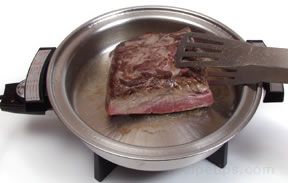 Some beef cuts are seared before they are roasted. Searing is a process in which the meat is browned quickly on all sides earlier it is roasted to create a flavorful crust. Searing is also used for tougher cuts that subsequently will exist cooked with a slow, moist estrus process such as braising. |
Basic Steps for Roasting a Cut of Beef
| The post-obit roasting method works well for beef cuts that weigh most 2½ pounds. Adjustments in the roasting time will take to exist made if using a smaller or larger piece of meat. A peak sirloin butt roast, a tri-tip roast, or a superlative quality bottom round roast are skilful choices when using the following steps. | |
| Preheat the oven to 450°F. Remove the beefiness roast from the fridge and season the meat equally desired. The meat may also be marinated for several hours before information technology is roasted. This may be specially desirable if roasting a bottom round (pictured right), considering even a top quality lesser circular roast will not be as tender as the elevation sirloin butt or tri-tip roast. The marinating process will help to tenderize the meat. | 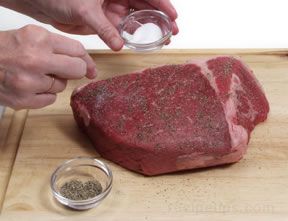 |
Note: Cooking a pocket-size roast at high heat helps to sear the outside, which provides a flavorful brown crust and tender meat on the inside.
| Identify the beef on a rack in a shallow roasting pan with the fat side up. Do not cover the roast and do not add together any liquid (liquid is used for braising, not roasting). | 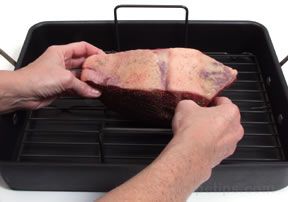 |
| Let the beefiness to roast at 450°F for 45 minutes then brainstorm checking the internal temperature of the meat with a meat thermometer. Continue roasting the meat until the internal temperature has reached 5 or 10 degrees beneath the desired doneness. The full roasting time depends on the type of beef cutting that is roasted, the weight of the beef cut, the level of doneness desired, and the accuracy of the oven. Generally, the roasting time may range from fifteen to 30 minutes per pound. The two½ pound, bottom round roast pictured on the right, required 55 minutes cooking time to achieve the desired doneness, which in this example is medium rare to medium. | 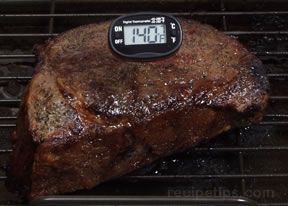 |
| Remove the roast from the oven and identify aluminum foil loosely over the meat to hold in the rut. Let the roast stand up for 15 minutes. The temperature will continue to ascent 5 or 10 degrees, reaching the proper doneness. The resting period will permit the juices to settle in the roast making information technology more tender and easier to carve. |  |
| A beef roast cooked to medium-rare should have an internal temperature of 145°F - 150ºF after the resting period, and a roast cooked to medium should accept an internal temperature of 150°F to 160ºF. (See the note beneath). Run into Beef Doneness for more information on proper cooking temperatures. | 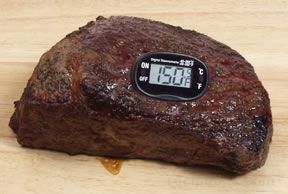 |
Annotation: Traditional guidelines country that beef cooked very rare, rare, or medium-rare should accept an internal temperature ranging betwixt 115ºF to 140°F; however, with increased business over bacteria that may be present in the internal portions of beef, the USDA recommends that whole beef cuts be cooked to an internal temperature of not less than 145°F (the last internal temperature after the resting period).
Steps for Roasting a Beef Tenderloin

- If you purchase a whole tenderloin that has non been trimmed, make sure that you trim off the fat layers and silverish skin before the meat is roasted.
- Preheat the oven to 425°F. Season the tenderloin with a liberal amount of salt and pepper.
- Tie the roast with pieces of twine at ane½ to two inch intervals after folding the narrow end of the tenderloin nether the roast.
- Place the meat into a roasting pan and pop it into the oven.
- Cook the roast for about 10 to 15 minutes and so turn information technology over in the pan. Go on to melt it for another x to xv minutes for every pound.
- Remove the tenderloin from the oven when the internal temperature of the meat reaches 140°F, as indicated on a meat thermometer inserted into the middle of the roast.
- Tent the roast with aluminum foil and let it to represent 20 minutes. This will let the juices to be redistributed throughout the tenderloin, which makes the carving process easier. The meat will be much more than tender than meat that is served as soon as it is pulled from the oven.
- The roast volition continue to cook as it rests and the internal temperature will ascent five°F to x°F, reaching 145°F to 150ºF. The roast may be carved into thick slices after the advisable resting menstruum. If y'all plan on serving a sauce fabricated from the pan drippings, it tin exist prepared while the tenderloin is resting.
Note: Some beef cuts that are usually undesirable for roasting, such as cuts from the plate or flank, may be improved considerably if they are marinated beginning earlier roasting. Marinating helps to soften the tough fibers, making the meat tender.
Steps for Roasting a Prime number Rib
Prime number rib is a common proper noun given to the beef cut, standing rib roast, or if the roast is boneless, it may be referred to every bit a rolled rib roast. "Prime number Rib" is a misleading proper name because many people presume that the meat is graded prime (by the USDA) when really this is non the case in most instances. Prime is the tiptop quality possible and represents only about 2% of the beef that is graded. It has the well-nigh marbling (the visible fatty running throughout the meat), which makes it the most flavorful and tender. In near cases, prime grade beefiness is available only at fine restaurants, and occasionally it may exist found in specialty meat markets, but it is rarely ever plant in supermarkets. In that location was a time, however, when rib roasts that were actually graded prime number were more than common than they are now, but the toll became so exorbitant that they are now only available at supermarkets through a special order. Most rib roasts sold in food stores are graded choice, and although this is one grade below prime, the roast is nevertheless quite desirable.
Because of its size, a full rib roast (ribs 6 through 12) is often cut and sold as ii divide roasts known as the get-go cut rib roast and the 2d cut rib roast. The first cut is too called a small-scale finish rib roast and includes ribs 9 or 10 through 12, which is side by side to the loin primal. The second cut, also known as the large stop rib roast, includes ribs half-dozen through 8 or 9 and is side by side to the chuck primal. Although it is very tender, its proximity to the chuck means that it is slightly less desirable than a first cutting rib roast.
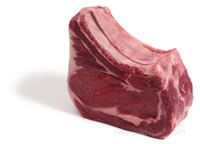
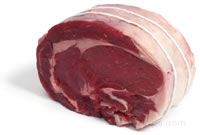
Continuing Rib Roast and Boneless Rolled Rib Roast
When determining the size of the prime rib roast that you will need, figure that each rib will feed two people. A iii rib roast will feed v or half dozen people, a iv rib roast will serve vii or 8 people, and so on. Information technology is all-time not to set up a rib roast of less than three ribs because it may be difficult to cook it properly. The smaller size increases the possibility of overcooking the meat.
| Preparing the Prime number Rib for Roasting | |
| A prime rib roast does not require too much training before information technology is cooked. The meat is much easier to piece of work with when the butcher removes the bones: the rib bones along the edge of the roast, which are connected to the chine os along the bottom. The rib and chine basic tin be removed every bit one piece, with some meat and fatty left between the private ribs in order to agree everything together and so that it can exist cooked as a separate piece if desired. | 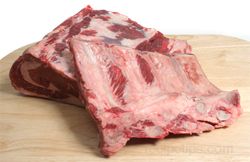 |
| It is much easier to carve a boneless rib roast when it is ready to serve than i that still includes the bones; however, information technology is beneficial to cook the bones with the boneless meat in order to provide the rib roast with additional season and moistness. To this end, if you accept previously removed the bones from the roast, information technology volition be necessary to tie the bones to the meat prior to cooking (see Tying Beefiness: Tying a Rib Roast for more information); however, before tying the roast, the fat should be trimmed in any areas where it is over an inch thick. Intendance must exist taken and then that too much fat is not removed. A minimum of one-quarter inch of fat should exist left on the meat, which will aid to seal in moistness and provide season. | |
| When the prime rib roast is properly trimmed and tied, information technology should be left covered at room temperature for two hours (assuming the room temperature is an average of 68ºF). Roasting common cold meat direct from the refrigerator will result in meat that is overdone on the outside before the internal temperature has reached the desired doneness; even so, considerations must be taken into account for the bodily temperature of the room in relation to the time the meat is abroad from refrigeration or from the oestrus of an oven. It may not exist wise to get out the meat sitting for two hours in a room that is excessively warm (above 80ºF) considering of concerns of foodborne illness resulting from food exposed to temperatures conducive to rapid growth of harmful bacteria. In this case, a time of but an hour and a half may be required to warm the meat sufficiently prior to roasting. | 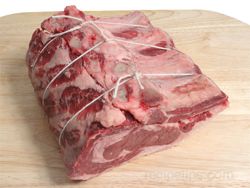 |
| After the prime rib has reached room temperature, rub the unabridged surface with pepper and kosher salt. This is oft the all-time way to bring out the flavor of the meat; however, many people like to include other flavorings that are either rubbed onto the surface of the meat or added to a flavoring liquid that is used to marinate the meat for a period of time. A rib roast certainly does not need to exist marinated to tenderize it because it is already a naturally tender beefiness cut, but a marinade (or a rub) may be used when specific flavors are desired in the meat (meet annotation box below). | 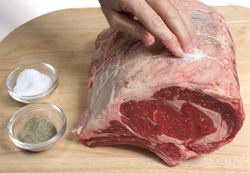 |
Note: To marinate the meat, place the prime rib in a dish or pan with sides (do not utilise plastic). Using a fork, poke holes throughout the roast; pour the marinade over the meat; cover; and place it in the refrigerator for two hours. Turn the roast in the marinade every xxx minutes. When the marinating time is finished, remove the meat from the marinade and allow it to sit at room temperature for one to two hours prior to roasting.
| Place the roast, rib side down, in a blistering pan or roasting pan that has high sides. A pan with a rack is not required considering the bones act every bit a natural rack for the prime rib meat. The prime number rib is now gear up to be placed into the oven for roasting. | 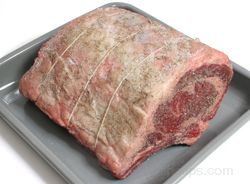 |
Roasting the Prime Rib
The most important betoken to remember when cooking a prime number rib roast is to ensure that the meat is non overcooked. An expensive cutting of beef, such every bit a prime rib roast, is most frequently all-time in flavor and tenderness when it reaches a doneness level of no greater than medium-rare; however, many chefs recommend that information technology exist served rare. The meat volition toughen rapidly when cooked too long (any level to a higher place medium), so information technology is important to watch information technology carefully during the roasting fourth dimension. Use a reliable meat thermometer to ensure that the internal temperature of the meat does not exceed the level of desired doneness.
Notation: The temperatures for doneness stated in this article are not recommended by the USDA simply are accepted levels of doneness for prime number rib recommended by many chefs. See Beefiness Doneness for information concerning the USDA accustomed standards for cooking beef.
A Typical Procedure for Cooking Prime number Rib
- Preheat the oven to 450°F. Place the prime rib roast (prepared as previously described) on a lower rack of the preheated oven.
- Cook the roast for 15 minutes. The high heat (450°F) will sear the outer surface of the meat, producing a somewhat crispy outside.
- Later on cooking the meat for 15 minutes at 450°F, reduce the heat to 325°F. Do non open the oven. Cook the prime number rib at 325°F for approximately 11 to 13 minutes per pound.
| Estimated Cooking Times The cooking times in this nautical chart are based upon a cooking Utilize a meat thermometer to ensure that | ||
| No. of Ribs / | Estimated Cooking Fourth dimension | |
| Rare 120°F to 125°F | Medium Rare 130°F to 135°F | |
| 3 Ribs | i-one/4 to ane-1/2 hrs. | 1-1/2 to 1-3/4 hrs. |
| 4 Ribs viii.5 to 10 lbs. | i-1/2 to 2 hrs. | 1-3/4 to two-1/4 hrs. |
| 5 Ribs ten.5 to thirteen lbs. | 2 to 2-1/2 hrs. | 2-ane/4 to two-three/iv hrs. |
| 6 Ribs 14 to 16 lbs. | two-1/two to 3 hrs. | 3 to 3-1/2 hrs. |
| 7 Ribs 16.5 to 18 lbs. | three to 3-i/2 hrs. | 3-1/2 to iv hrs. |
| 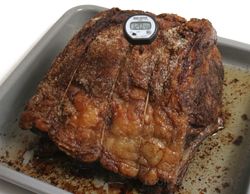 |
| |
| 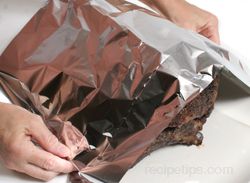 |
Serving the Prime Rib
When the resting period has ended, the prime number rib tin be carved and served. Refer to "Carving Beefiness" Steps for Etching a Prime number Rib Roast for information regarding the proper method of etching of the meat.
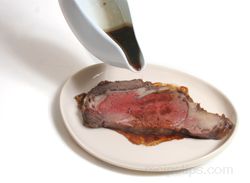 Prime rib is often served au jus (pronounced oh zhoo'), which is French for "with juice." Since au jus means "with juice," it is more proper to refer to prime rib as being "served au jus" rather than referring to it as "served with au jus," which would really mean "served with with juice." The juices are spooned over the meat when it is served.
Prime rib is often served au jus (pronounced oh zhoo'), which is French for "with juice." Since au jus means "with juice," it is more proper to refer to prime rib as being "served au jus" rather than referring to it as "served with au jus," which would really mean "served with with juice." The juices are spooned over the meat when it is served.
Au jus is prepared from the meat drippings produced while the prime rib is cooking. After the meat is removed from the pan and is allowed to rest, fat is removed from the drippings in the pan, additional goop is added, the juices are boiled, the roasting pan is deglazed to remove the flavorful $.25 from the pan, seasoning is added, and the juices are strained (if desired). Come across Prime Rib Serving Suggestions in "Kitchen Techniques" for detailed information on how to prepare au jus.
Source: https://www.recipetips.com/kitchen-tips/t--372/roasting-beef.asp
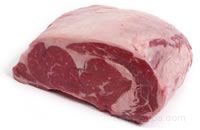
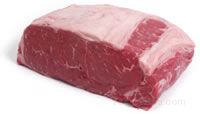
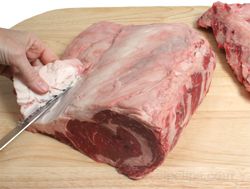
0 Response to "Should I Cover a Roast Beef While Baking"
Enregistrer un commentaire